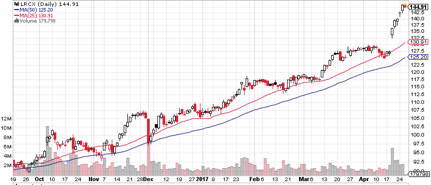Two weeks ago, Alcoa (AA) served up its Q4 results for the investing world to see. If the stock-investing world has an equivalent of the swallows coming back to Capistrano (which signals the arrival of spring) or Mardi Gras (which marks the beginning of Lent), it’s Alcoa’s earnings release, which means we’re in for another round of Earnings Madness.
For some reason, tradition or earnings season competitive spirit, perhaps, Alcoa is traditionally the first big company to drop its numbers every quarter. This time (Q1 2017), the news came out after the market closed on April 24. As usual for Alcoa, that’s pretty quick work after a quarter-end.
[text_ad]
[The news from Alcoa was very good: earnings of 63 cents per share on revenue of $2.66 billion, which represented a 202% jump in EPS and a 25% hike in sales. Alcoa stock (AA) responded positively, although its advance mirrors the remarkable rally in the broad market, so it’s hard to say whether the report or the market made the bigger contribution.]
I’m going to give you a quick walk through the world of quarterly reports (a “backgrounder” as they say in the news biz) and list a few rules that will let you get through a year’s worth of earnings without blowing a gasket or reducing your portfolio’s value too much.
Why Earnings Season?
Why is there an earnings season? It’s because the Securities and Exchange Commission (SEC), which writes the rules for equities listed on U.S. stock exchanges, says so.
According to the SEC, every publicly traded company has to file a Form 10-Q (for quarterly) unaudited financial statement for each of the first three quarters of the company’s fiscal year. And at the end of the fiscal year, there must be a 10-K report, an official, audited disclosure of all significant financial information.
Just as a side note, there’s really no reason for a company to have its fiscal year conform to the calendar year. Many retailers have fiscal years that end in January, which gives them until February to clean up after the holiday season, get their inventory straight and do their books. In fact, companies’ fiscal years end in virtually every month. Maybe they get a discount on their auditing for avoiding the peak season?
Big and medium-sized companies get 40 days from the end of the quarter to file. Small companies (market cap of $75 million or less) get 45 days. Annual reports are due within 60 days of year’s end from companies with a market cap of $700 million or more, 75 days for companies whose market caps are $75 million or more, but less than $700 million, and 90 days for small caps (less than $75 million).
Earnings Hits and Misses: So What?
Most of the evidence that equity investors use to decide on which stocks to buy is probabilistic. There are no guarantees. A company that has been growing revenues and earnings quarter after quarter may keep the string going … or may not. And a stock with a low P/E ratio and good growth prospects may be ready to start climbing … or not.
But earnings season, when investors compare companies’ results with the “consensus numbers” (an average of the estimates of all the analysts who are following that company) is generally pretty clear in its verdict. If a company is supposed to make a nickel per share but makes six cents, that’s a beat. Everyone’s happy. If revenue was supposed to top $200 million but the report says $199 million, that’s a miss. Nobody’s happy.
Hitting the consensus numbers generally supports a stock’s price. Exceeding the number often leads to a jump in price, including the “gap up” that investors love to see. A stock that pops higher on the day after earnings (especially if volume has also spiked higher) often gets a dose of momentum that will power it to further gains.
Here, for example, is a chart of Lam Research (LRCX), a maker of wafer fabrication etching and cleaning equipment that’s been doing well as the microchip cycle has lifted interest in the sector. The stock hasn’t been exactly shabby since catching an updraft in early December, but you can clearly see the burst of energy that the company’s April 24 earnings report provided. With earnings climbing by 137% and revenue up 64%, it’s hardly surprising that investors are ready to chase LRCX higher despite missing estimates slightly on revenue. It may, in fact, be a little extended, as its 25-day moving average is back at 131, but a good earnings report can really stoke the boilers on a stock.
LRCX illustrates one of the exceptions to the earnings rules. If management gives a convincing reason for the miss, or issues positive guidance to future performance, the damage can be contained, or even reversed. And LRCX is showing no damage at all.
The real keys to earnings season are, first, to be aware of when a quarterly report is coming and, second, to have a plan firmly in place for what you will do when the reaction comes. A mental stop to limit losses is always a good idea. And a plan for increasing your investment if the reaction is good may also make sense.
Know what’s coming. Have a plan. Sounds like a good idea for just about every situation.
[author_ad]



